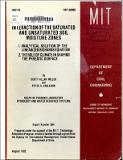| dc.contributor.author | Miller, Scott Allan | en_US |
| dc.contributor.author | Eagleson, Peter S. | en_US |
| dc.date.accessioned | 2022-06-13T13:10:20Z | |
| dc.date.available | 2022-06-13T13:10:20Z | |
| dc.date.issued | 1982-08 | |
| dc.identifier | 284 | |
| dc.identifier.uri | https://hdl.handle.net/1721.1/143022 | |
| dc.description | Scanning notes: Disclaimer inserted for quality (too many pencil marks to erase). | en_US |
| dc.description | Prepared under the support of the M.I.T. Technology Adaptation Program, which is funded through a grant from the Agency for International Development, United States Department of State. | en_US |
| dc.description.abstract | In Part I, dimensionless analytical expressions are derived describing the hydrologic processes and the moisture distribution of a high water table unsaturated soil column, by linearizing Richards' equation. The finite Fourier transform method is used to solve for the moisture content, which is the basis for the solutions for the depth-averaged moisture content, ponding time, boundary fluxes and their integral quantities. The effects of transpiration are included through three models of soil-water extraction by plants. Simplified, physically-based expressions for infiltration rate-and ponding time which include water table effects, are proposed in the appendix. Examples of the solutions are presented and several cases are compared with a numerical finite-element model of the non-linear problem. Fitted parameter estimates are compared with analytical expressions from the literature. Comparisons are for average moisture content, ponding time and cumulative infiltration. Good to excellent agreement is found for all cases. The exfiltration solutions, with and without vegetation, are untested. In Part II, the dynamic relation between soil-moisture, water table depth, and accretion to groundwater is studied. Derived relations between the moisture content, water table depth, and net accretion are compared over a range of climate and soil types. These are used in a one dimensional non-linear finite-difference model for the water table shape and the longer run influence of climate upon it. The boundaries are constant potentials. The water table is shown to have an influence for depths from less than one meter to over one hundred meters, with the greater influence for clay soils and larger potential evaporation rates. Climate-induced water table depressions and swamplands are shown to be dependent upon the unsaturated zone water balance and upon the hydraulic conductivity of the soil. Case studies for the water table-water balance model use data from the El-Gizera and Bahr-el-Ghazal regions of Sudan. In both parts of this work, dimensionless parameters are developed to describe when the water table influences the water balance of unsaturated soil and when the climate influences the water table shape. | en_US |
| dc.publisher | Cambridge, Mass. : Ralph M. Parsons Laboratory, Hydrology and Water Resource Systems, Massachusetts Institute of Technology, Dept. of Civil Engineering | |
| dc.relation.ispartofseries | R (Massachusetts Institute of Technology. Department of Civil Engineering) ; 82-43. | |
| dc.relation.ispartofseries | Report (Ralph M. Parsons Laboratory for Water Resources and Hydrodynamics) ; 284. | |
| dc.relation.ispartofseries | TAP report | |
| dc.title | Interaction of the Saturated and Unsaturated Soil Moisture Zones. 1. Analytical Solution of the Linearized Richards Equation. 2. The Role of Climate in Shaping the Phreatic Surface | en_US |
| dc.identifier.oclc | 10427173 | |
| dc.identifier.aleph | 241103 | |
